|
THE POINTLESS TRUTH
Digging up the ghosts of the ancient past
In the wake of the many recent scandals regarding corrupt reviewing in videogames magazines, it's all too easy to forget that bent and/or incompetent reviewers have been with us for pretty much as long as videogames have. Bungs, intimidation and corruption aren't new phenomena, and even some of the most venerable figures in gaming-mag history have been guilty of selling out their readers for inducements of one sort or another. In this exciting new WoS series, we take a look at journalistic treachery through the ages and, belatedly and entirely pointlessly, seek the truth.
No.1 - SINCLAIR USER REVIEWS NEMESIS
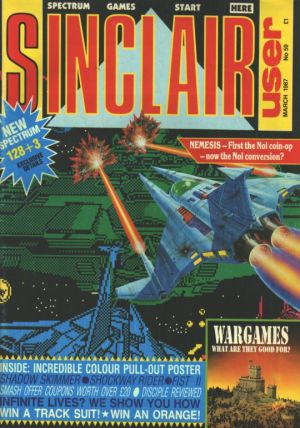
Quite nice graphics work on the cover, to be fair.
In late 1986, arcade giants Konami had decided to move into the business of releasing conversions of its own games in the 8-bit home-computer market, having previously licensed its big coin-op hits like Hyper Sports, Mikie and Green Beret to established publishers like Ocean and Imagine. Perhaps spoiled by the excellent quality of Imagine's ports of most of the titles, gamers welcomed the news excitedly, naturally assuming that Konami itself - with full access to all the resources of the arcade titles - would do an even better job.
The first sign that these hopes would be cruelly dashed came with the first release, an abysmally dire Spectrum port of the excellent coin-op Jail Break in which all the effort had been expended on the graphics, enabling adverts and reviews to conceal the absence of even such basic functions as eight-way movement, never mind more abstract niceties like three-dimensional collision detection (your policeman's path could be blocked by obstacles positioned around his hat) or gameplay which at least passingly resembled the original game.
But, with it still being 1987 and videogame consumers not having had their innocence and trust in the gaming press completely destroyed yet, Speccy gamers still waited optimistically for the conversion of Nemesis, the groundbreaking coin-op scrolling shooter which pioneered the idea of selectable powerups. And when Sinclair User came out with the first review of the game, it looked as though their waiting and hopes hadn't been in vain.
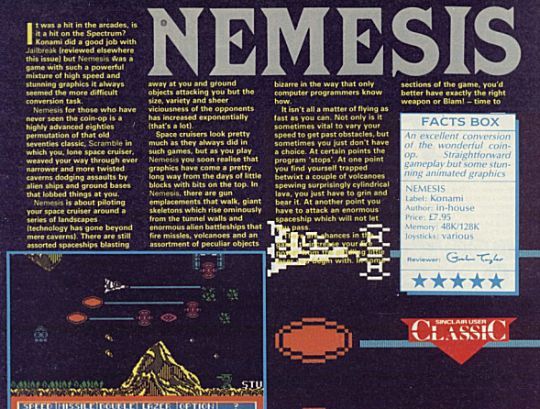
(Click the picture for the full review.)
Now, SU chucking out five-star reviews wasn't in itself anything to get excited about in 1987 - for one thing, the awful Jailbreak had also scored five out of five (compared to a miserable 47% in Crash), and the mag was notorious in general for its wildly generous marking, a trait that was also underpinned by a striking lack of knowledge when it came to games ported to the Speccy from the arcades. (Although on this particular occasion the mag showed an eerie prescience, twice linking Nemesis to Konami's earlier arcade hit Scramble. The coin-op company itself wouldn't claim that Scramble was actually the first game in the Nemesis - aka Gradius - series until 15 years later, when the GBA title Gradius Galaxies retrospectively listed Scramble as, effectively, "Gradius 0" in its chronology intro sequence.)
Nobody in their right mind ever bought a game on the strength of a Sinclair User review score alone. But what really sold Nemesis to SU readers were the screenshots. Depicting a beautiful-looking rendition of the game which was surely the best the Speccy could ever have been expected to produce, the shots showed detailed graphics faithful to the coin-op, awash with colour and activity. The coin-op's most distinctive and important features all seemed to be present and correct, and the review text appeared to back that impression up. Unfortunate readers who took the mag at its word (and pictures) were in for a nasty shock.
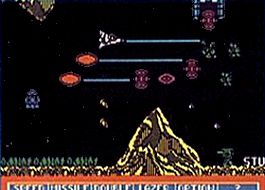 
(Left) Sinclair User's depiction of Level 1, from the mag's review.
(Right) The closest it's possible to get to that picture on the Speccy's real Level 1.
The screenshots above show the grisly reality that was Nemesis on the Spectrum. There's barely a true pixel in Sinclair User's picture - the trademark mountains have become feeble little hillocks; the scale-defining tree line is gone; the SU shot illustrates two red "Options" satellites unleashing blue lasers, and with the powerup bar at the bottom indicating that your ship still has further Options available to it, while in Speccy reality you could only attach a single, feeble, white Option with a drippy white laser; several non-existent types of enemy craft; and the onscreen play area has been shrunk by around a third, with your ship's range of movement restricted to about half the height of the screen.
(Those, of course, are just the cosmetic changes. There were all manner of horrors lurking in the gameplay too for the unsuspecting dupes who'd believed SU's "excellent conversion" schtick, though it's actually not a terrible game in its own right. Shots blocked by explosions, terrible collision detection, Double shots which fired at uselessly shallow angles instead of the proper 45 degrees, wild speed fluctuations, and unlike the coin-op you could smash into the floor or ceiling without coming to harm.) So far so suspicious, then.
 
(Left) Level 5, as seen by Sinclair User.
(Right) Level 5, as seen by everyone else.
Later levels fared no better, as can be seen in the Level 5 shots above. Now, alert readers may have noticed that most of the magazine's pictures feature the letters "STU" in the bottom right-hand corner - this isn't a rubbish WoS attempt at watermarking, but in fact the signature of Nemesis' graphics artist, Stuart Ruecroft. Hmm. What's going on here?
Now, at this point cynical readers may well be thinking "That's easy - I know what's happened. Just like Official Xbox Magazine did with Headhunter Redemption, the lazy, useless writer has simply reviewed the game from some press-release screenshots and blurb without actually bothering to play it. Tch!"
But in fact, the truth appears to be something a little weirder than that. How do we know this? Because of Jon Riglar's Zap Chat.
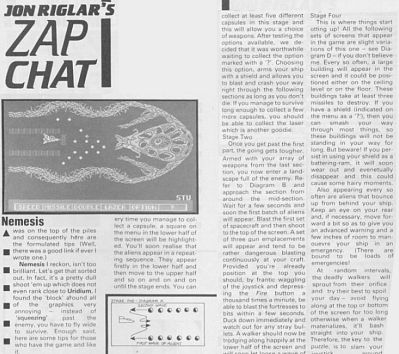
(Click on image for composite full page.) Zap Chat was SU's tips section. A couple of months after the review, it dedicated a large chunk of its pages to Nemesis tips. The piece opened with something of a disclaimer, in which the tips-section host disassociated himself from the glowing praise of the review:
"Nemesis, I reckon, isn't too brilliant. Let's get that sorted out. In fact, it's a pretty dull shoot-'em-up which does not even rank close to Uridium." [The Speccy's standard bearer for horizontally-scrolling shooters at the time.]
But following that came a page of writing which is either a stupendous feat of extended invention, some random clueless rambling, or evidence that the version of Nemesis reviewed by SU - vastly superior to the one the people who bought the game got to play - actually really existed. For a start, the tips were illustrated with some more screenshots bearing no resemblance to the released version of the game, both featuring the "STU" signature again. They're of the game's Level 7 and Level 8 bosses, yet the text of the tips - printed three months after the review - clearly implied that the tips writer couldn't get past Level 1.
Faintly astonishingly, SU had devoted around perhaps 1,200 words of tips to the less-than-strenuous task of getting off the first level of a game that had been out for weeks. Long paragraphs and diagrams were devoted to explaining how to tackle sections of the game that last for two seconds and feature only one enemy, which can be destroyed with a single shot. What's more, despite this absurd level of detail, the writer still got the tips pathetically wrong - the very first waves of enemies were described as attacking "in groups of about six", when in fact they attack in waves of exactly five. (True enough, five IS "about six", but you'd think if you were going to tip the game on an insanely-detailed, second-by-second, enemy-by-enemy basis you could at least count the numbers in the first wave accurately.)
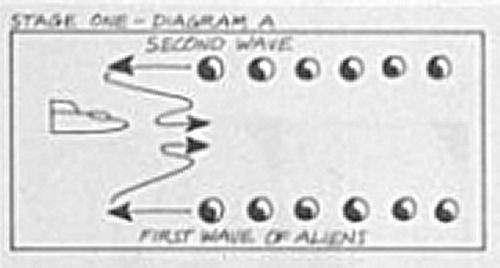
A fantastic and useful hand-drawn diagram with only 20% too many enemies in it.
Incredibly bizarrely, the tips-section writer then went on to assert that after the last section of Level 1, "All the following sets of screens that appear in the game are slight variations of this one". This is a statement so mind-stretchingly far from any truth that your correspondent is at a total loss as to what it could ever possibly have been meant to mean. (Whatever else can be said about the poor quality of the conversion, Speccy Nemesis is at least faithful to the original in that the levels are all extremely distinct from each other.)
So why give a game so much precious magazine space, dedicated to such glaringly bad "tips", for the first stage, an age after it's come out, and when everyone who was ever going to buy it had bought it weeks ago and was therefore highly unlikely to need 1,200 words of tips on getting past the opening five seconds of Level 1? (Word had got out about the quality of Nemesis quickly, and sales after the first month were dismal. It debuted at No.9 then disappeared from the Top 20 the very next month. Incidentally, have a click on the picture below left - which comes from the issue of SU with the review in it - to notice something odd about the pic they illustrated the game's brief chart life with three issues later.)
And if the tipster had only got through the first level, where did the screenshots of Levels 7 and 8 come from? And why, three months on from the review, were they still from an obviously monstrously-fake version which could, by then, be identified as such by every reader of the magazine who'd ever seen the game? What the?
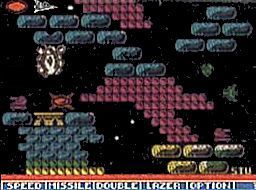 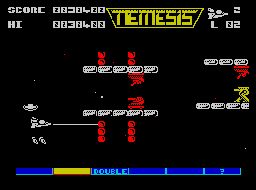
(Left) A particularly good-looking fake SU screenshot of Level 2.
(Right) Level 2 as it actually was.
There aren't very many plausible explanations for the Sinclair User Nemesis Mystery. After much pondering, the only one that seems to make sense is this: there really was another, better version of Speccy Nemesis. Because the alternative - that SU reviewed a game on the sole basis of some wildly unrepresentative mocked-up screenshots, purely in order to get the review a month earlier than Crash (and three before YS), is just too mad to be true.
As the five-star Jailbreak review showed, SU didn't need to use fake screenshots in order to give terrible games high scores, so their only logical motivation would have been to get the first review of a major new publisher's debut releases (uniquely, SU reviewed Nemesis and Jailbreak in the same issue - the other Speccy mags got Jailbreak well before Nemesis) by using unfinished code, only to be overtaken by events when a different version had to be released to the shops in the intervening time. Of course, SU then had to either stick brazenly to their version of reality, or admit what they'd done and risk a scandal.
(The decision to go with the former was adhered to doggedly - when SU reviewed the budget re-release of Nemesis three and a half years later, the reviewer uses almost the whole page to criticise the graphics, but still concludes that the game is "brilliant" and gives it 81%. All the screenshots come from Level 1, but are of the real version of the game.)
That would also make sense of the bizarre tips coverage. If SU had a superior Nemesis, it may well have been a beta one which couldn't fit all the levels or graphics into memory (or something similar), explaining why it didn't get released. But of course, if SU had done tips based on their version, the levels would all have been in the wrong places. Level 1 is the only stage where the released Speccy port is laid out fairly accurately compared to the coin-op - so it would probably have been more or less the same in our notional better version, and hence "safe" to write playing tips for without letting the dodgy review cat out of the bag.
 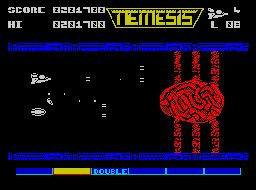
(Left) The tips section's version of the Nemesis ultimate boss (black-and-white page).
(Right) The same final screen as seen in the real game, with the same weaponry.
This theory is backed up somewhat by the Your Sinclair review, which is a rather wet effort (credited to the mysterious "Tommy Nash", but whose picture is actually that of the mag's publisher Kevin Cox in dark glasses) awarding the game a stupidly generous 8/10 score. (YS's reviews were never up to the standards of the mag's writing, though, either ethically or judgementally, a fact often overlooked in the rose-tinted view of nostalgia - Crash, with the publication's characteristic candour, gave it 48%.) But the YS piece mentions at the start that Nemesis has finally arrived "after countless reprogrammings" supposedly undertaken in - sure enough - an attempt to fit it all into the Speccy's memory.
(This is slightly odd in itself, as the 128K version of the machine was quite well established by this point, but the hellish multiloads which characterised the dying years of the Speccy still weren't widely accepted and it'd have been madness to exclude the 48K market in 1987, when it still made up by far the majority of Spectrum owners.)
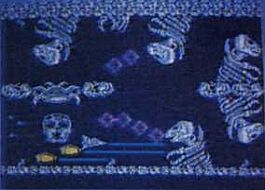 
(Left) YS preview shot, resembling the version reviewed by SU.
(Right) Crash preview shot from two months later, resembling the released version.
Still more interestingly, the shots above are taken from the previews run in YS and Crash. The YS preview (the month before SU's review) shows a pic very similar to the SU shot of Level 5 (but not actually the same, further discounting the "SU reviewed it from the press release" theory). Crash's preview, meanwhile - from the month AFTER the Sinclair User review - depicts a game somewhere in between the two, with the "LAZER" mis-spelling of the SU version corrected, but with clearly work-in-progress graphics (the missing title logo and score info at the top, for example) that are much more akin to the released version. The Crash preview also ends on the following paragraph:
"The Nemesis that we received from Konami's representative was the latest working version available. However it is still incomplete, and the game has yet to be approved by Konami... until this approval is given, any 'reviews' which you may read are premature - and probably inaccurate!"
Fascinatingly, the month after the SU tips appeared, the mag's own letters page printed - seemingly apropos of nothing - a letter from Konami's "Nemesis Management Co. Ltd". The letter, which reads more like a phone message answering some unheard query, asserts that only one minor change - the removal of the second Option, for speed reasons - was made to the game between the mag seeing it and the release. It also bemoans the fact that the programmers have apparently disappeared off the face of the Earth, to whereabouts unknown to Konami. (They later returned to make Jackal, Konami's final self-published Speccy game - except that none of the named programmers in the development team has Nemesis listed in his individual credits on World Of Spectrum.)

The subtitular suffix "The Final Challenge" is unique to the Speccy, CPC and C64 versions.
So the evidence for Sinclair User having reviewed a nicer-looking beta version (rather than just reviewing and marking it based on some fake screenshots) in order to get the exclusive seems reasonably convincing. Whether a victim of innocent circumstance or not (and the latter seems more likely), SU's behaviour is still utterly reprehensible, of course. They must have been well aware that the pictures they were printing bore no resemblance to the game their readers would buy (certainly when they continued to print them months after it was finally released), and would be highly likely, in conjunction with the carefully vaguely-worded review, to induce them to go and waste their cash on it. (And at £7.95, Nemesis was at the most expensive end of Speccy pricing at the time.)
But as we've already noted, it was a foolish reader who spent money on the basis of an SU review anyway, so caveat emptor, we suppose.
Much more important than that, though - where the heck is the good Nemesis?
|

